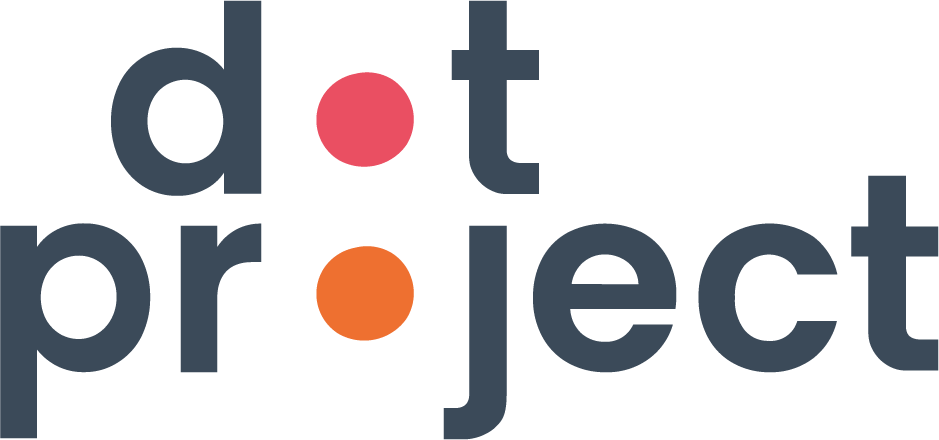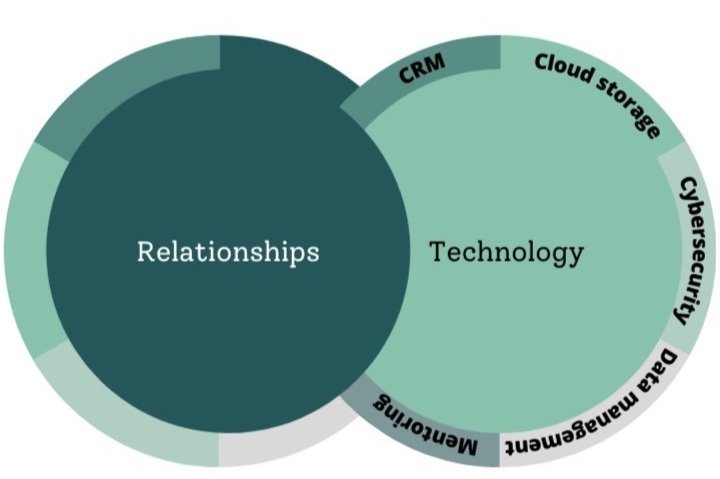How relationships and technology can radically improve your organisational infrastructure
Over the last eighteen months to two years, we have observed an increased need for nonprofits to build solid technology and relational foundations. We recently gave a talk at Catalyst's monthly Network Meetup on how we are supporting organisations within the social economy to review and improve their organisational infrastructure in this way.
WHAT DO WE MEAN BY ORGANISATIONAL INFRASTRUCTURE?
‘Infrastructure’ can be defined as ‘the basic, underlying framework or features of a system or organisation’. In the sector this is understood as a system or function that is core to the business, and has traditionally included general resources, skills and funding. At DOT PROJECT infrastructure implies ‘building’ and maintaining core technology and relationships, which is the backbone of a solid organisational infrastructure.
We believe that the less ‘shiny’ or glamourous area of maintenance is hugely important for financial planning and organisational resilience. Knowing and understanding your full cost base is paramount, but in the area of technology and human relationships this cost base is so often unknown, unquantified and thus unplanned for. By default, this makes being adaptive to any changes particularly challenging for an organisation to navigate. For example, some organisations are quite comfortable with paying monthly premises rent (perhaps less so with the move to home working!) but much less comfortable or even aware of the increasing monthly/annual ‘tech rent’ they may incur as they increase their use of technology. There are numerous examples of this in practice e.g. using a ‘free’ version of a SaaS (Software as a Service) product and then needing to rapidly add users which requires a paid subscription with a per user per month cost - some of which can rack up very quickly, even with a nonprofit discount.
SO, WHY IS DOT PROJECT CONSCIOUSLY MOVING AWAY FROM THE WORD DIGITAL AND ADOPTING ORGANISATIONAL INFRASTRUCTURE?
We want to support organisations to build their technological and relational resilience. Over the last few years, and more specifically during the last eighteen months we’ve worked with numerous social economy organisations and have witnessed many of the same themes surface. We have found an increased need to provide solid technology and relational foundations, and that many organisations have a gap in skills that would be traditionally filled by a Chief Technical Officer (CTO) or chief systems architect. We know that small charities often don't have the resources for these roles, and that they can be siloed in larger organisations, thus lacking a holistic viewpoint across the full organisational landscape. In the October Catalyst monthly Network Meet up session, participants also mentioned that organisations are juggling with the debate of whether they employ tech skills in house or access them externally through technical partners or consultants - which gives the added complexity of managing a skill set and role they may not feel equipped to manage.
Technology and human relationships are core to organisational infrastructure. This is a core focus of our work. By positioning relationships at the centre of everything we do, we can best support organisations to build the technology foundations which enable them to thrive and to design the services that allow their users to meet their specific goals and objectives.
Organisational Infrastructure
A digram representing organisational infrastructure and the different components that come together to build a strong organisational infrastructure for charities.
SO, HOW ARE WE IMPROVING ORGANISATIONAL INFRASTRUCTURE THROUGH TECHNOLOGY AND HUMAN RELATIONSHIPS?
As a team we talk about ‘Making the invisible visible’. By this we mean understanding the overall landscape of an organisation and surfacing the risks and opportunities so they are aware of their organisational infrastructure, and can make informed decisions about where to go next.
We start by creating awareness and acknowledgement that investing in the process is important. Creating and strengthening technology and human relationships within an organisation is not always easy, takes time, but it is worth it. Only 30% of digital transformations succeed because they require a major shift in mindsets and behaviours, so from the start of any project, we work on creating a culture that’s responsive to change, and a mindset that works collaboratively. Our approach includes alignment sessions, co-facilitation, coaching and training as ways of delivering. Once we have an understanding of the relationships that make up the organisation, we shift our focus on the technology, auditing the tools, processes and ways of working. This sensemaking helps us provide the organisation with a recommendations report and tailored mentoring as they work through the recommendations.
We do a detailed technology discovery survey followed by discovery calls and focussed deep dives around all of technology, tools, processes and ways of working across the organisation. We spend time sensemaking all of the information surfaced and provide the organisation with a recommendations report and roadmap as well as tailored follow up sessions as they work through the recommendations.
“At DOT PROJECT, we support organisations to manage technology and human relationships as core organisational infrastructure. ”
— Kirsty Cameron, DOT PROJECT Member
A practical example is a charity seeking support in reviewing their data management and governance as well as helping them streamline their IT support. Through our process we were able to provide an overview of the risks and opportunities for the organisation both with their data management and governance but also provide a clear prioritisation and route forward for their IT support and partnerships. Crucially, as they now have confidence in their systems and approach, they can spend time on delivering services to their beneficiaries.
INTERESTED IN APPLYING THE APPROACH? WE’D SUGGEST THE FOLLOWING:
A tech discovery survey - depending on how big your organisation is this could be a survey you send around or it could be a series of conversations with your colleagues to elicit the information. Find out ALL of the tools, systems, hardware and software that is being used across your organisation, what the costs are for using the software (including licences, maintenance charges, hosting, service agreements etc).
Run a tech audit - using the information from the survey as a starting point, allocate a dedicated time and bring people from across the organisation together. Spend time deep diving into each system/tool as well as workflows, data flows, processes and ways of working, costs, how each tool or process is being used and by whom. Capture all this information.
Review and sensemake the information - look for risks and opportunities.
Are there tools that are duplicating a task (e.g. communication) where you could streamline the process?
Are there tools or processes that operate in a silo but could be joined up?
Are there gaps where a tool or process might need to be introduced?
Are there any risks you need to address around data, tools, costs, training, workflows or processes?
If you’re a charity, are you making use of any charity discounts on tools, systems or software?
Prioritise and take action - prioritise the highest risk items first and then work through a plan for actioning your findings.
We’d suggest reviewing your technical infrastructure regularly.
And remember the human relationship element throughout the process!
We’re passionate about the impact that strong organisational infrastructure can have for social impact organisations across the country. We’ll continue to advocate for and explore the funding landscape around technological resilience. For us at DOT PROJECT it feels both timely and necessary to educate and advocate around the importance of funding for core organisational infrastructure.
We are always curious so if you’ve read this and have any thoughts, comments or reflections you’d like to share with us or chat about, please reach out to us at hello@dotproject.coop.
USEFUL RESOURCES
We’ve developed resources that address some of the key technology problems that charities have raised with us over the last eighteen months which can be found on the resources page of our website.
Fellow DOT PROJECT member, Nicola Chowings Thomas has recently written this article on ‘What happens when tech transformations lack joined up thinking’ for The Giving Machine charity.

